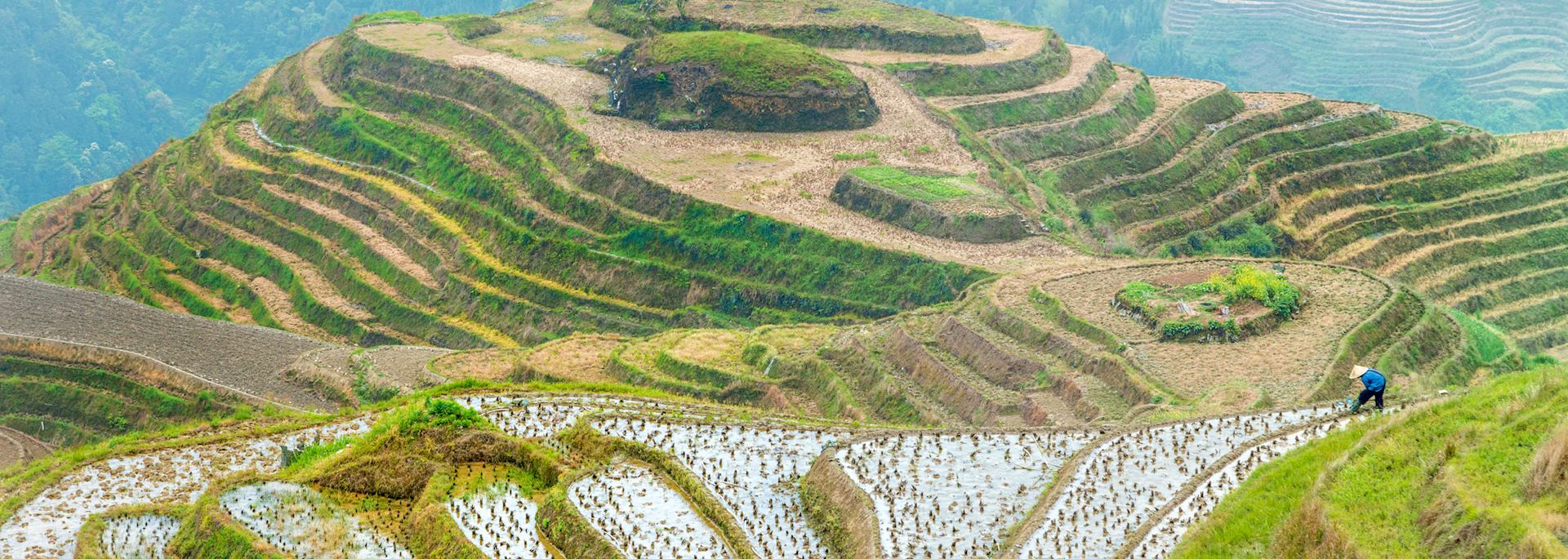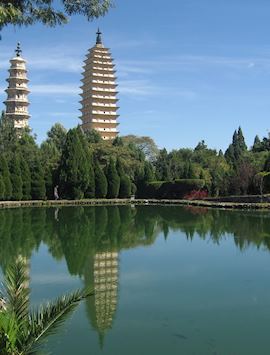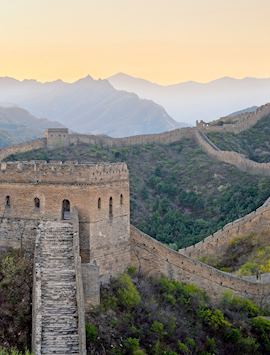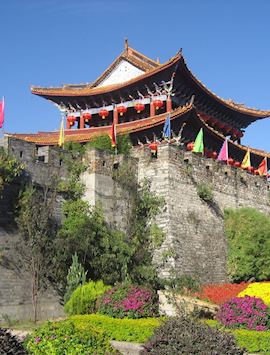By China specialist Cheryl
I like experiencing the shift in pace when I travel from China’s megacities to the predominantly rural regions of Yunnan, Guizhou and Guangxi. You can go from dining in Shanghai’s Michelin-starred restaurants to sipping home-brewed rice wine around a local family’s table, swapping sleek skyscrapers for swirling rice terraces.
Despite China’s population becoming increasingly urban, there are vast swathes of land where people still live a rural existence. Farmers plough their fields using water buffalos, cormorant fishermen float along the river on bamboo rafts, and leisurely bicycle rides bring you to minority villages where deep-rooted traditions are still a way of life.
Holidays in Yunnan province
This is the area of China I most enjoy visiting. It’s very different culturally to the rest of the country — over half of China’s 56 ethnic minorities live here, and there are influences from Laos, Vietnam and Myanmar, which border the province to the south and west. Its landscapes range from rolling green hills to snow-covered mountains as you approach the Himalayan foothills, catering well to hikers.
Dali, Yunnan’s historic city

You can fly directly into the historic city of Dali. Capital of the Bai minority culture, here you’ll see local people dressed in their traditional white clothing (Bai means ‘white’ in Chinese).
Set on Erhai Lake, the city has a walled old town with cobbled streets and traditional stone buildings. You can take a boat ride on the lake with a guide before visiting the Three Pagodas of Chongsheng Temple on Dali’s outskirts. Built during the 9th and 10th centuries, the pagodas are arranged in a triangle, the tallest reaching 70 m (227 ft).
I also explored the markets around Dali — alongside the usual fresh fruit and vegetables you’ll find tie-dyed fabrics, for which the area is renowned. The tie-dying method had been used here for over 1,000 years — long before it became associated with 1960s hippies.
I recommend staying at the Linden Centre in Xizhou village, just outside Dali. Housed in a wood and stone building set around four courtyards, it has 14 rooms and two suites and a peaceful air. While there you can take part in Chinese calligraphy and cooking classes and Bai musical instrument lessons.
World Heritage Site city of Lijiang
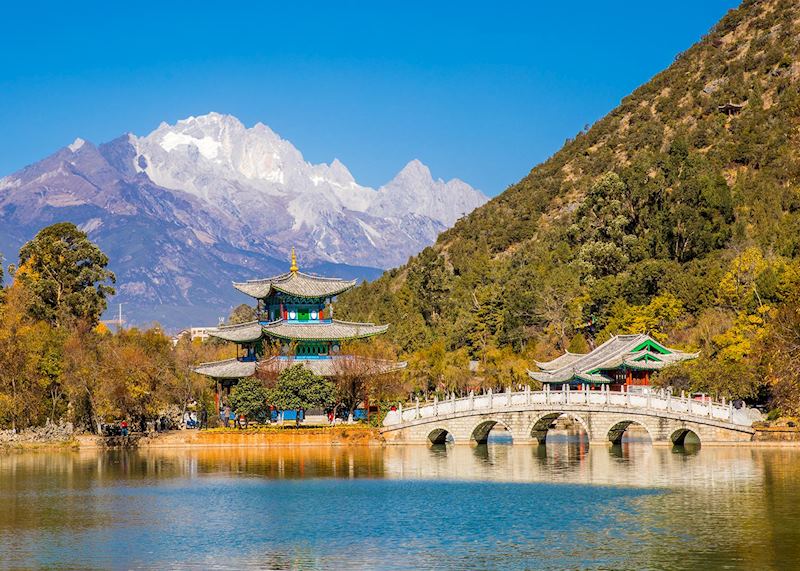
From Dali, I recommend heading to the old town of Lijiang, a three-hour drive away. UNESCO has designated it a World Heritage Site for its Qing-dynasty architecture, which features carved beams and arched gateways typical of the Naxi culture that thrives here.
With the massif of Jade Dragon Snow Mountain forming a backdrop and clear mountain streams running through its narrow, cobbled streets, Lijiang is the most beautiful old town I’ve seen on my travels.
To get away from the crowds, though, I suggest visiting some of the surrounding Naxi villages, which give you a sense of what Lijiang was like before it hit people’s radars. Here, you meet local villagers going about their day. Women wear customary wide-sleeved gowns and you’ll encounter them working on intricate embroidery or selling fresh vegetables while chatting in groups on the street.
Just outside Lijiang, the Banyan Tree is a hotel styled around Naxi architecture with modern comforts such as a spa. Some rooms and suites have private gardens with plunge pools, and there’s a Cantonese restaurant set beside a koi pond.
Tiger Leaping Gorge
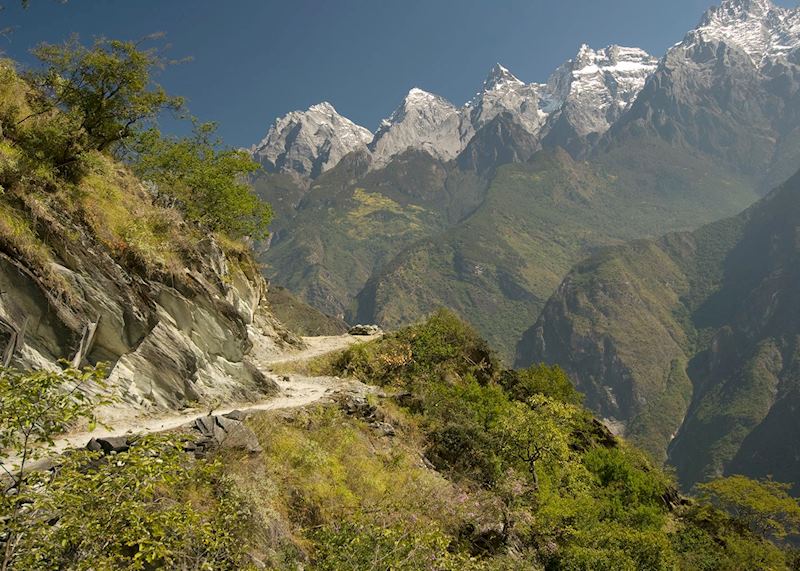
Lijiang is a gateway to Tiger Leaping Gorge, which winds for 16 km (10 miles) through the Haba Mountains. I embarked on a memorable two-day trek through the gorge which, with a maximum depth of 3,900 m (12,795 ft), is one of the deepest in the world.
The first day involves a six-hour ascent through incredible scenery — steep, craggy limestone cliffs rise up from both sides of the Jinsha River, whose roar gets fainter as you climb. Excluding the occupants of the occasional Naxi village, I barely saw anyone else. It was this feeling of being cut off from the world that made the trek special for me.
We eventually arrived at a simple guesthouse high in the mountains overlooking the gorge. The Halfway Lodge has basic facilities, but it’s perfectly comfortable after a day of trekking and you can watch the sunset over the gorge from its terrace.
The next day’s trek is mostly downhill, passing waterfalls that trickle or gush down the rock face, the water fresh enough to drink. Once at the bottom of the gorge, you’re met by a private driver for the two-hour journey to Shangri-La.
Tibetan-influenced Shangri-La

In Yunnan’s northwest corner, Shangri-La stands surrounded by soaring mountains at an elevation of 3,160 m (10,370 ft). It’s here Tibetan influences first began to trickle into China, with 80% of the population identifying as Tibetan.
You’ll notice the architecture here is markedly different — the ground floors of houses are used for sheltering animals, with the family living above. Prayer flags blow in the wind and, up on a hill in the middle of the old town, a 24 m (80 ft) tall golden prayer wheel glints in the sun. I watched as local Buddhists offered their prayers and turned the huge wheel (it takes around six people to move it).
The imposing Songzanlin Monastery, built in the 17th century, stands high above the city’s outskirts. It’s the largest Lamaist monastery outside Tibet, with around 650 red-robed monks of all ages living and chanting within its walls. Inside is a labyrinth of prayer halls, and my guide knew which ones would be quietest for me to experience the peaceful, sacred atmosphere away from other visitors.
Songtsam Hotel is around ten minutes outside Shangri-La, right next to the Songzanlin Monastery. I was warmly greeted with a cup of ginger tea — said to help with the high altitude — and given a pair of slippers to wear inside.
The building is traditionally Tibetan, and there’s a small library overlooking the seasonal Lamuyangcuo Lake. While there, I tried the area’s main delicacy: tender yak meat cooked on the bone. I also had a few sips of yak butter tea, which is definitely an acquired taste.
Holidays in Guangxi province
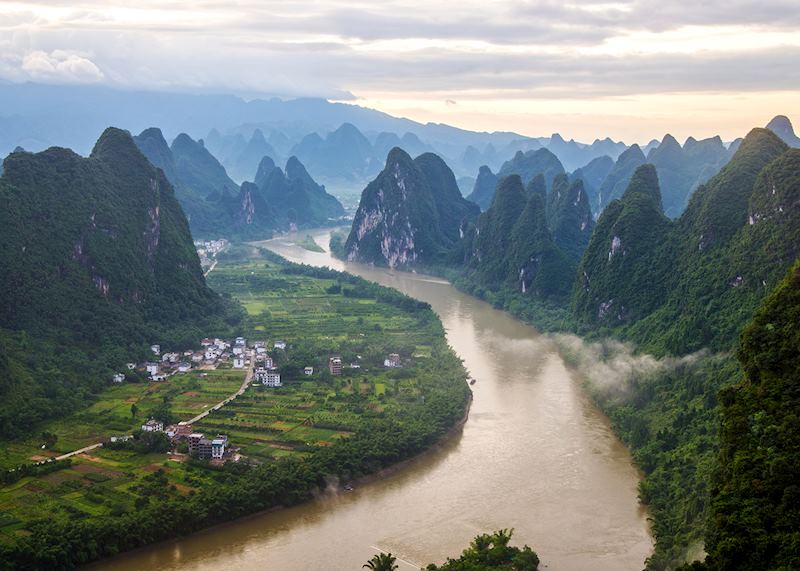
As soon as I landed in Guilin, Guangxi’s main city, I was struck by the huge limestone karst peaks creating bumps in the surrounding landscape. Despite being a major city, Guilin feels more laid-back and less developed than other cities. Its position on the shores of the Li River makes it a gateway to the region’s truly rural areas. I recommend heading off straight away to explore.
Li River cruise
A cruise along the Li River is by far the best way to take in the scenery, which is reminiscent of Vietnam’s Halong Bay, but on a grander scale. The four-hour boat journey over to Yangshuo is so visually impressive it appears on the 20 yuan note.
The guides on board point out some of the more distinctive karsts. It feels a bit like cloud-spotting as you make out shapes in the stone, from dragon heads to horses. The effect of the otherworldly karsts shrouded in mist resulted in a hushed silence on board at times as everyone absorbed their surroundings.
Along the way, you pass riverside villages where farmers work the fields with their buffalos, and the children play on the water’s edge. Local people drift past on their bamboo rafts, catching fish or just getting from A to B. This is a side of rural China you don’t see from the road.
Riverside Yangshuo
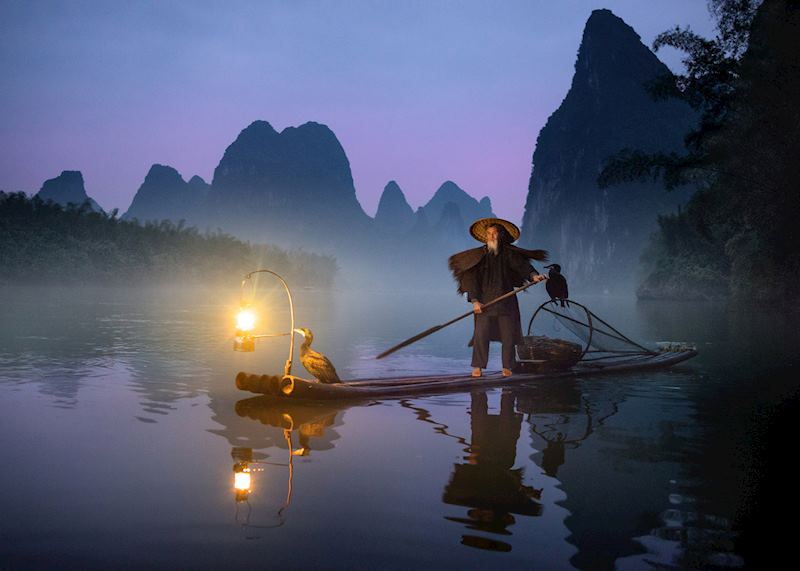
The town of Yangshuo, set on the banks of the Li River and surrounded by limestone pinnacles, is a place where things are done at your own pace. The terrain is generally flat and you can hire a bicycle and ride around the outlying rice paddies to local villages. Everyone I passed greeted me with a smile or a wave.
My guide and I spent one evening floating on a bamboo raft alongside a local cormorant fisherman, watching as his tethered bird plunged into the water to catch fish. Cormorants are trained by the fishermen to return their catch to the rafts, although the birds sometimes sneak a meal for themselves.
Yangshuo Mountain Retreat is set beside the Yulong River on the outskirts of the town. While simple, the property is authentic, using locally made bamboo furniture. Each room has its own balcony, and you can enjoy home-cooked meals on the riverbank. Most of the staff are local to the area, and emphasis is placed on environmental sustainability.
Dragon’s Backbone rice terraces, Longji
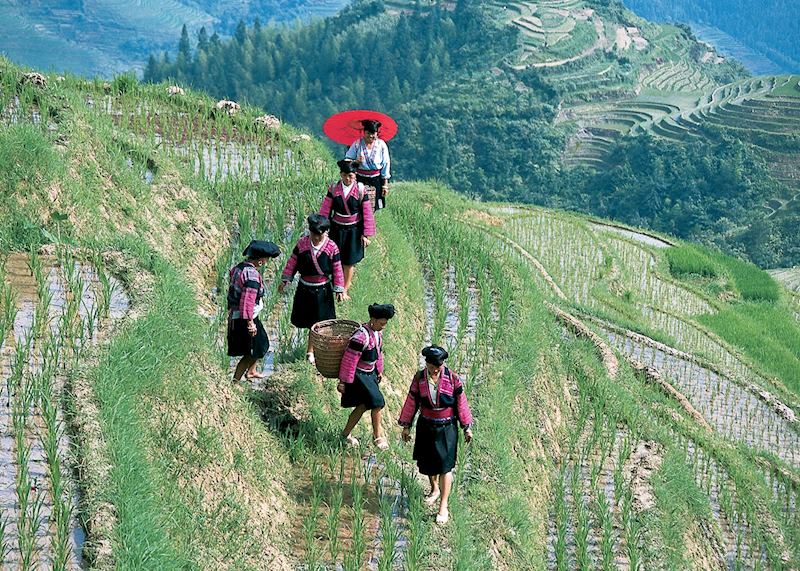
It takes around three hours to drive through the countryside from Yangshuo to the rippling swirls of Longji’s rice terraces. While you can visit for the day, I recommend spending a night here to experience the terraces in the early morning and evening, when barely any other visitors are around.
Stretching for miles, the corrugated hills and valleys are occasionally broken up by small clusters of wooden houses. It’s easy to take for granted that, as these terraces and villages are inaccessible by road, everything you see was either handmade there or carried up by people and donkeys.
You can take guided walks through the terraces, where workers are occasionally seen tending their crops. I walked with my guide from the village of Pingan to another called Dazhai, the terraces stretching out before me in seemingly never-ending waves. Just five other visitors passed us during the entire six-hour hike.
Dazhai is home to people of the Yao minority culture. The women only cut their hair once during their lifetime to mark their wedding day; it’s cut again once they’re deceased. They wear it coiled on top of their head and covered in a headdress that indicates their marital status.
On the high slopes of Pingan village, Li-An Lodge is a simple, traditionally styled guesthouse looking out over a sea of terraces. The views when I opened the curtains in the morning were worth the steep 40-minute walk to reach the lodge. Each room is themed on an aspect of Chinese culture.
Holidays in Guizhou province
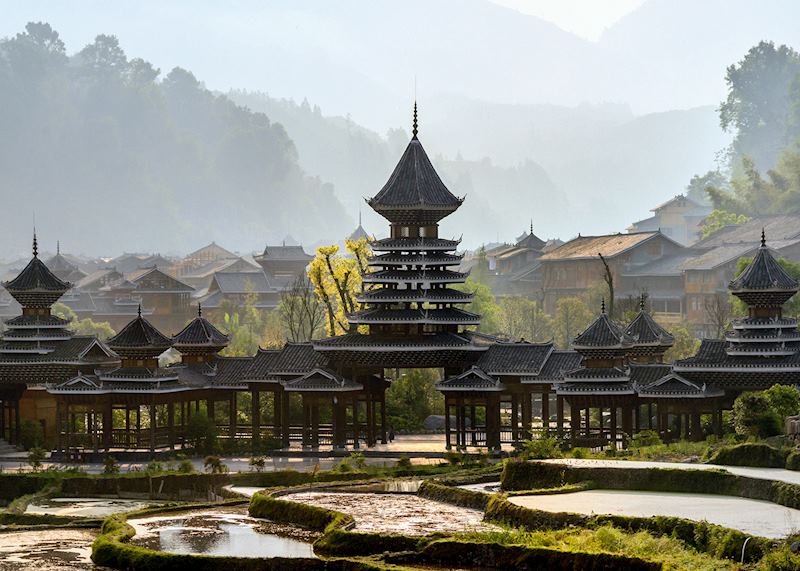
Comprising forested mountains, hills and valleys that stretch untouched for miles, Guizhou province is relatively unknown to people outside China. Around 37% of its population is made up of minority groups, including Miao, Dong, Yao, Zhang and Qiang, making it one of the most culturally diverse provinces in the country.
Generally, you fly into the city of Guiyang, which has the best-quality hotels in the area, though most are international chains. From here, you can head out each day with your guide to a different minority village. Alternatively, stay in a simpler property in one of the villages scattered across the countryside.
My guide, Tim, would visit these rural villages even in his spare time, so he knew the best places to take me. We visited the Dong village of Zhaoxing. Here, wind and rain bridges (wooden bridges with features such as decorative tiled roofs, pavilions and verandas) stretch across streams. Dark wood houses — some with working waterwheels — are perched above the rice paddies.
I paused to watch local women bashing newly dyed clothes with mallets to make the indigo pigment smooth and shiny. I was also invited into several wood-and-stone homes for a cup of tea, where I learned about the Dong culture’s matriarchal society.

We also visited a Miao village to have lunch with a local family. The custom is to drink a buffalo horn of home-brewed rice wine before you enter the home, another before you eat and a final toast after the meal.
We ate a spicy fish hot pot, and we communicated through my guide and various hand gestures — the different dialects spoken in this area sometimes prevent your guide from translating word for word.
Afterwards, I was shown the local fishing technique in the surrounding rice paddies — you look for air bubbles on the surface of the water and then up end a woven basket over where you estimate the fish to be. After many attempts to catch a fish, I decided to leave it to the experts.
Best time to visit rural China
Spring (April and May) and autumn (September and October) are generally the best times to go, as temperatures are comfortable and there’s less chance of rain than in the hot and humid summer months. It’s best to visit Guangxi in the autumn, as spring marks the start of the rainy season.
Start planning your trip to China
Start thinking about your experience. These itineraries are simply suggestions for how you could enjoy some of the same experiences as our specialists. They're just for inspiration, because your trip will be created around your particular tastes.
View All Tours in China
